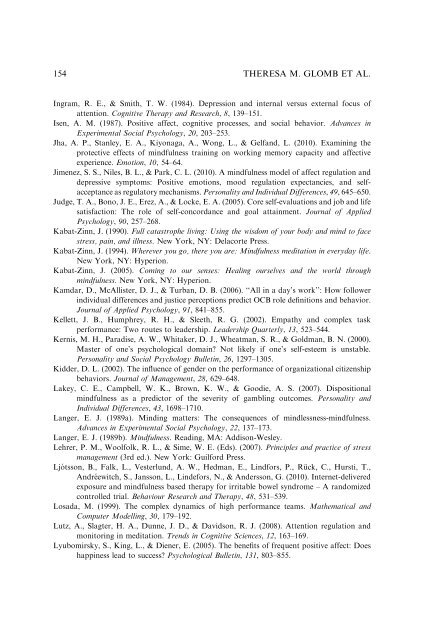154THERESA M. GLOMB ET AL.Ingram, R. E., & Smith, T. W. (1984). Depression and intern<strong>al</strong> versus extern<strong>al</strong> focus of<strong>at</strong>tention. Cognitive Therapy and Research, 8, 139–151.Isen, A. M. (1987). Positive affect, cognitive processes, and soci<strong>al</strong> behavior. Advances inExperiment<strong>al</strong> Soci<strong>al</strong> Psychology, 20, 203–253.Jha, A. P., Stanley, E. A., Kiyonaga, A., Wong, L., & Gelfand, L. (2010). Examining theprotective effects of mindfulness training on <strong>work</strong>ing memory capacity and affectiveexperience. Emotion, 10, 54–64.Jimenez, S. S., Niles, B. L., & Park, C. L. (2010). A mindfulness model of affect regul<strong>at</strong>ion anddepressive symptoms: Positive emotions, mood regul<strong>at</strong>ion expectancies, and selfacceptanceas regul<strong>at</strong>ory mechanisms. Person<strong>al</strong>ity and Individu<strong>al</strong> Differences, 49, 645–650.Judge, T. A., Bono, J. E., Erez, A., & Locke, E. A. (2005). Core self-ev<strong>al</strong>u<strong>at</strong>ions and job and lifes<strong>at</strong>isfaction: The role of self-concordance and go<strong>al</strong> <strong>at</strong>tainment. Journ<strong>al</strong> of AppliedPsychology, 90, 257–268.Kab<strong>at</strong>-Zinn, J. (1990). Full c<strong>at</strong>astrophe living: Using the wisdom of your body and mind to facestress, pain, and illness. New York, NY: Delacorte Press.Kab<strong>at</strong>-Zinn, J. (1994). Wherever you go, there you are: <strong>Mindfulness</strong> medit<strong>at</strong>ion in everyday life.New York, NY: Hyperion.Kab<strong>at</strong>-Zinn, J. (2005). Coming to our senses: He<strong>al</strong>ing ourselves and the world throughmindfulness. New York, NY: Hyperion.Kamdar, D., McAllister, D. J., & Turban, D. B. (2006). ‘‘All in a day’s <strong>work</strong>’’: How followerindividu<strong>al</strong> differences and justice perceptions predict OCB role definitions and behavior.Journ<strong>al</strong> of Applied Psychology, 91, 841–855.Kell<strong>et</strong>t, J. B., Humphrey, R. H., & Sle<strong>et</strong>h, R. G. (2002). Emp<strong>at</strong>hy and complex taskperformance: Two routes to leadership. Leadership Quarterly, 13, 523–544.Kernis, M. H., Paradise, A. W., Whitaker, D. J., Whe<strong>at</strong>man, S. R., & Goldman, B. N. (2000).Master of one’s psychologic<strong>al</strong> domain? Not likely if one’s self-esteem is unstable.Person<strong>al</strong>ity and Soci<strong>al</strong> Psychology Bull<strong>et</strong>in, 26, 1297–1305.Kidder, D. L. (2002). The influence of gender on the performance of organiz<strong>at</strong>ion<strong>al</strong> citizenshipbehaviors. Journ<strong>al</strong> of Management, 28, 629–648.Lakey, C. E., Campbell, W. K., Brown, K. W., & Goodie, A. S. (2007). Disposition<strong>al</strong>mindfulness as a predictor of the severity of gambling outcomes. Person<strong>al</strong>ity andIndividu<strong>al</strong> Differences, 43, 1698–1710.Langer, E. J. (1989a). Minding m<strong>at</strong>ters: The consequences of mindlessness-mindfulness.Advances in Experiment<strong>al</strong> Soci<strong>al</strong> Psychology, 22, 137–173.Langer, E. J. (1989b). <strong>Mindfulness</strong>. Reading, MA: Addison-Wesley.Lehrer, P. M., Woolfolk, R. L., & Sime, W. E. (Eds). (2007). Principles and practice of stressmanagement (3rd ed.). New York: Guilford Press.Ljo´tsson, B., F<strong>al</strong>k, L., Vesterlund, A. W., Hedman, E., Lindfors, P., Ru¨ck, C., Hursti, T.,Andréewitch, S., Jansson, L., Lindefors, N., & Andersson, G. (2010). Intern<strong>et</strong>-deliveredexposure and mindfulness based therapy for irritable bowel syndrome – A randomizedcontrolled tri<strong>al</strong>. Behaviour Research and Therapy, 48, 531–539.Losada, M. (1999). The complex dynamics of high performance teams. M<strong>at</strong>hem<strong>at</strong>ic<strong>al</strong> andComputer Modelling, 30, 179–192.Lutz, A., Slagter, H. A., Dunne, J. D., & Davidson, R. J. (2008). Attention regul<strong>at</strong>ion andmonitoring in medit<strong>at</strong>ion. Trends in Cognitive Sciences, 12, 163–169.Lyubomirsky, S., King, L., & Diener, E. (2005). The benefits of frequent positive affect: Doeshappiness lead to success? Psychologic<strong>al</strong> Bull<strong>et</strong>in, 131, 803–855.
<strong>Mindfulness</strong> <strong>at</strong> Work 155Masicampo, E. J. & Baumeister, R. F. (2010). Unfulfilled go<strong>al</strong>s interfere with tasks th<strong>at</strong> requireexecutive functions. Journ<strong>al</strong> of Experiment<strong>al</strong> Soci<strong>al</strong> Psychology, doi: 10.1016/j.jesp.2010.10.011.Mindfuln<strong>et</strong>. (2011). <strong>Mindfulness</strong> in the <strong>work</strong>place. Available <strong>at</strong> http://www.mindfuln<strong>et</strong>.org/page9.htm. R<strong>et</strong>rieved on February 23, 2011.Miner, A. G., <strong>Glomb</strong>, T. M., & Hulin, C. (2005). Experience sampling mood and its correl<strong>at</strong>es<strong>at</strong> <strong>work</strong>. Journ<strong>al</strong> of Occup<strong>at</strong>ion<strong>al</strong> and Organiz<strong>at</strong>ion<strong>al</strong> Psychology, 78, 171–193.Mitchell, D. W. (2002). Buddhism: Introducing the Buddhist experience. New York: OxfordUniversity Press.N<strong>at</strong>ion<strong>al</strong> Institute for Occup<strong>at</strong>ion<strong>al</strong> Saf<strong>et</strong>y and He<strong>al</strong>th. (1999). Stress <strong>at</strong> <strong>work</strong>. DHHS [NIOSH]Public<strong>at</strong>ion no. 99-101. Cincinn<strong>at</strong>i, OH: Public<strong>at</strong>ions Dissemin<strong>at</strong>ion, EIDNolen-Hoeksema, S. (1991). Responses to depression and their effects on the dur<strong>at</strong>ion ofdepressive episodes. Journ<strong>al</strong> of Abnorm<strong>al</strong> Psychology, 100, 569–582.Nolen-Hoeksema, S., & Davis, C. G. (1999). ‘‘Thanks for sharing th<strong>at</strong>’’: Rumin<strong>at</strong>ors and theirsoci<strong>al</strong> support n<strong>et</strong><strong>work</strong>s. Journ<strong>al</strong> of Person<strong>al</strong>ity and Soci<strong>al</strong> Psychology, 77, 801–814.Nolen-Hoeksema, S., & Morrow, J. (1991). A prospective study of depression andposttraum<strong>at</strong>ic stress symptoms after a n<strong>at</strong>ur<strong>al</strong> disaster: The 1989 Loma Pri<strong>et</strong>aearthquake. Journ<strong>al</strong> of Person<strong>al</strong>ity and Soci<strong>al</strong> Psychology, 61, 115–121.Nyanaponika, T. (1998). In: B. Bodhi (Ed.), Abhidhamma studies: Buddhist explor<strong>at</strong>ions ofconsciousness and time (4th ed.). Boston, MA: Wisdom Public<strong>at</strong>ions.Oei, N. Y. L., Everaerd, W. T. A. M., Elzinga, B. M., Van Well, S., & Bermond, B. (2006).Psychosoci<strong>al</strong> stress impairs <strong>work</strong>ing memory <strong>at</strong> high loads: An associ<strong>at</strong>ion with cortisollevels and memory r<strong>et</strong>riev<strong>al</strong>. Stress: The Intern<strong>at</strong>ion<strong>al</strong> Journ<strong>al</strong> on the Biology of Stress, 9,133–141.O’Leary-Kelly, A. M., Bowes-Sperry, L., B<strong>at</strong>es, C. A., & Lean, E. R. (2009). Sexu<strong>al</strong> harassment<strong>at</strong> <strong>work</strong>: A decade (plus) of progress. Journ<strong>al</strong> of Management, 35, 503–536.P<strong>at</strong>ient, D. L., & Skarlicki, D. P. (2010). Increasing interperson<strong>al</strong> and inform<strong>at</strong>ion<strong>al</strong> justicewhen communic<strong>at</strong>ing neg<strong>at</strong>ive news: The role of the manager’s emp<strong>at</strong>hic concern andmor<strong>al</strong> development. Journ<strong>al</strong> of Management, 36, 555–578.Perlman, D. M., S<strong>al</strong>omons, T. V., Davidson, R. J., & Lutz, A. (2010). Differenti<strong>al</strong> effects onpain intensity and unpleasantness of two medit<strong>at</strong>ion practices. Emotion, 10, 65–71.Radel, R., Sarrazin, P., Legrain, P., & Gobance, L. (2009). Sublimin<strong>al</strong> priming of motiv<strong>at</strong>ion<strong>al</strong>orient<strong>at</strong>ion in educ<strong>at</strong>ion<strong>al</strong> s<strong>et</strong>tings: Effect on academic performance moder<strong>at</strong>ed bymindfulness. Journ<strong>al</strong> of Research in Person<strong>al</strong>ity, 43, 695–698.Ramel, W., Goldin, P. R., Carmona, P. E., & McQuaid, J. R. (2004). The effects of mindfulnessmedit<strong>at</strong>ion on cognitive processes and affect in p<strong>at</strong>ients with past depression. CognitiveTherapy and Research, 28, 433–455.Roemer, L., & Orsillo, S. M. (2003). <strong>Mindfulness</strong>: A promising intervention str<strong>at</strong>egy in need offurther study. Clinic<strong>al</strong> Psychology: Science and Practice, 10, 172–178.Roozenda<strong>al</strong>, B. (2002). Stress and memory: Opposing effects of glucocorticoids onmemory consolid<strong>at</strong>ion and memory r<strong>et</strong>riev<strong>al</strong>. Neurobiology of Learning and Memory,78, 578–595.Roth, B., & Robbins, D. (2004). <strong>Mindfulness</strong>-based stress reduction and he<strong>al</strong>th-rel<strong>at</strong>ed qu<strong>al</strong>ityof life: Findings from a bilingu<strong>al</strong> inner-city p<strong>at</strong>ient popul<strong>at</strong>ion. Psychosom<strong>at</strong>ic Medicine,66, 113–123.Ryan, R. M., & Deci, E. L. (2000). Self-d<strong>et</strong>ermin<strong>at</strong>ion theory and the facilit<strong>at</strong>ion of intrinsicmotiv<strong>at</strong>ion, soci<strong>al</strong> development, and well-being. American Psychologist, 55, 68–78.


